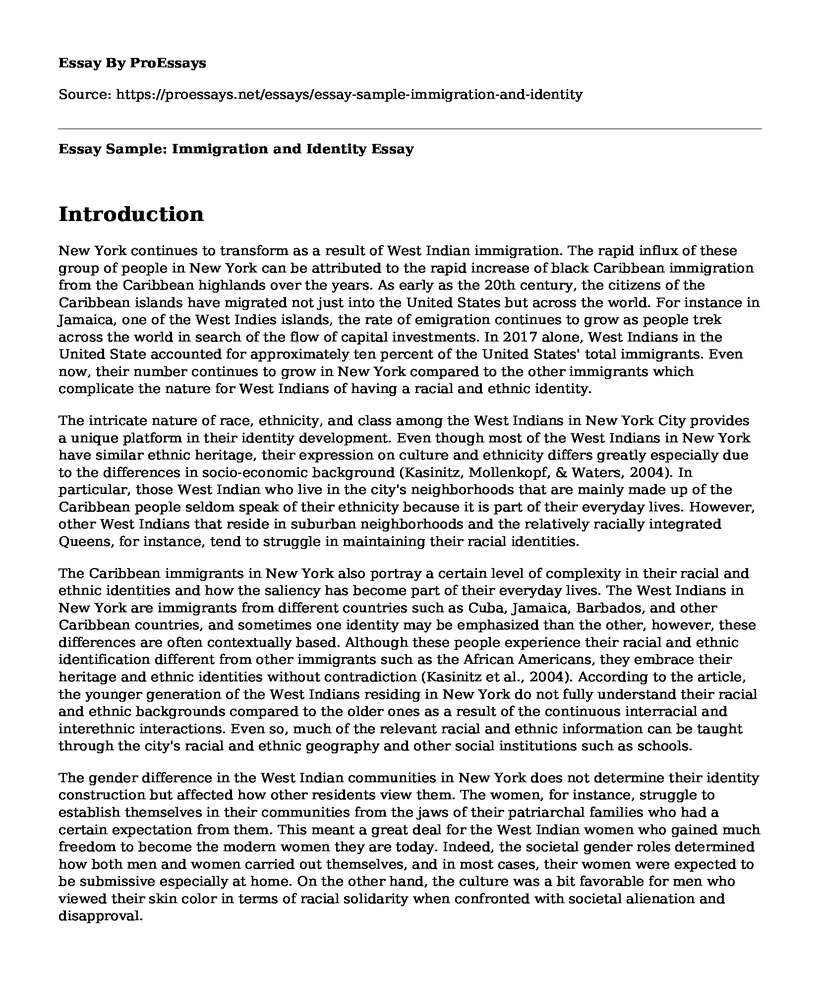Introduction
New York continues to transform as a result of West Indian immigration. The rapid influx of these group of people in New York can be attributed to the rapid increase of black Caribbean immigration from the Caribbean highlands over the years. As early as the 20th century, the citizens of the Caribbean islands have migrated not just into the United States but across the world. For instance in Jamaica, one of the West Indies islands, the rate of emigration continues to grow as people trek across the world in search of the flow of capital investments. In 2017 alone, West Indians in the United State accounted for approximately ten percent of the United States' total immigrants. Even now, their number continues to grow in New York compared to the other immigrants which complicate the nature for West Indians of having a racial and ethnic identity.
The intricate nature of race, ethnicity, and class among the West Indians in New York City provides a unique platform in their identity development. Even though most of the West Indians in New York have similar ethnic heritage, their expression on culture and ethnicity differs greatly especially due to the differences in socio-economic background (Kasinitz, Mollenkopf, & Waters, 2004). In particular, those West Indian who live in the city's neighborhoods that are mainly made up of the Caribbean people seldom speak of their ethnicity because it is part of their everyday lives. However, other West Indians that reside in suburban neighborhoods and the relatively racially integrated Queens, for instance, tend to struggle in maintaining their racial identities.
The Caribbean immigrants in New York also portray a certain level of complexity in their racial and ethnic identities and how the saliency has become part of their everyday lives. The West Indians in New York are immigrants from different countries such as Cuba, Jamaica, Barbados, and other Caribbean countries, and sometimes one identity may be emphasized than the other, however, these differences are often contextually based. Although these people experience their racial and ethnic identification different from other immigrants such as the African Americans, they embrace their heritage and ethnic identities without contradiction (Kasinitz et al., 2004). According to the article, the younger generation of the West Indians residing in New York do not fully understand their racial and ethnic backgrounds compared to the older ones as a result of the continuous interracial and interethnic interactions. Even so, much of the relevant racial and ethnic information can be taught through the city's racial and ethnic geography and other social institutions such as schools.
The gender difference in the West Indian communities in New York does not determine their identity construction but affected how other residents view them. The women, for instance, struggle to establish themselves in their communities from the jaws of their patriarchal families who had a certain expectation from them. This meant a great deal for the West Indian women who gained much freedom to become the modern women they are today. Indeed, the societal gender roles determined how both men and women carried out themselves, and in most cases, their women were expected to be submissive especially at home. On the other hand, the culture was a bit favorable for men who viewed their skin color in terms of racial solidarity when confronted with societal alienation and disapproval.
Conclusion
In conclusion, the population of the West Indians continues to grow in New York compared to the other immigrants which complicate the nature for West Indians of having a racial and ethnic identity. Even though they have similar cultural backgrounds and heritage, their expression on race and ethnicity greatly differs in terms of socio-economic background. The report indicate the working class West Indians identifies more with their heritage because they live in neighborhoods majorly composed of their ethnic groups. The middle class on the other hand is live in integrated communities. Also, these people embrace their heritage and ethnic identities without contradiction despite immigrating from different countries in the Caribbean islands. Their differences are usually seen to be contextually based. Moreover, their gender difference is a nonfactor in their identity construction but influences how others view them and sometimes how they view themselves. The women have gained much freedom from their patriarchal families.
Discussion Questions
What are some of the ways in which the Immigration of Western Indians and their children in New York have been transforming the city as they occupy and form communities there?
In what ways are the second generation West Indians differ from their parents? What are some of their experiences growing up in the boroughs of New York City?
Do the second generation West Indians understand the current categories of identity formation? In what was do they obtain this knowledge?
How does the shifting demographics of New York City's recent immigrates communities especially the African American communities, affect the identity and the heritage of the West Indians?
References
Kasinitz, P., Mollenkopf, J. H., & Waters, M. C. (Eds.). (2004). Becoming New Yorkers: Ethnographies of the new second generation. Russell Sage Foundation.
Cite this page
Essay Sample: Immigration and Identity. (2022, Dec 08). Retrieved from https://proessays.net/essays/essay-sample-immigration-and-identity
If you are the original author of this essay and no longer wish to have it published on the ProEssays website, please click below to request its removal:
- Persuasive Speech Outline on the Problem of Cyber Bullying
- Social Factors Affecting Perception Essay Example
- Essay Sample on Bullying in the Workplace
- Global Inequality and Poverty Essay Example
- Essay on Racism and Hate Crimes: A Look Into the Past and Present
- Essay Example on Inmates' Rehab: A Crucial Step to Successful Reintegration
- Essay Example on Sacrifice Zones: The Poorest Places in America







